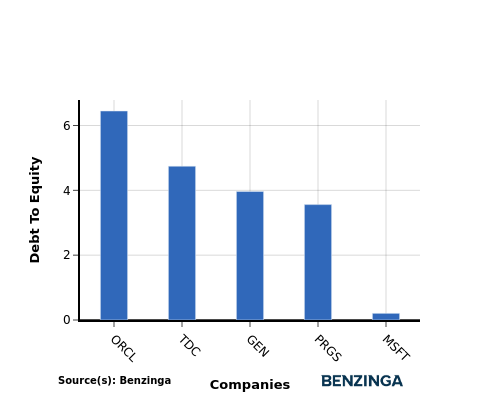In today's fast-paced and highly competitive business world, it is crucial for investors and industry followers to conduct comprehensive company evaluations. In this article, we will delve into an extensive industry comparison, evaluating Microsoft MSFT in relation to its major competitors in the Software industry. By closely examining key financial metrics, market standing, and growth prospects, our objective is to provide valuable insights and highlight company's performance in the industry.
Microsoft Background
Microsoft develops and licenses consumer and enterprise software. It is known for its Windows operating systems and Office productivity suite. The company is organized into three equally sized broad segments: productivity and business processes (legacy Microsoft Office, cloud-based Office 365, Exchange, SharePoint, Skype, LinkedIn, Dynamics), intelligence cloud (infrastructure- and platform-as-a-service offerings Azure, Windows Server OS, SQL Server), and more personal computing (Windows Client, Xbox, Bing search, display advertising, and Surface laptops, tablets, and desktops).
| Company | P/E | P/B | P/S | ROE | EBITDA (in billions) | Gross Profit (in billions) | Revenue Growth |
|---|---|---|---|---|---|---|---|
| Microsoft Corp | 33.30 | 10.15 | 11.79 | 8.17% | $36.79 | $47.83 | 12.27% |
| Oracle Corp | 41.97 | 34.93 | 8.88 | 25.66% | $5.75 | $9.97 | 8.64% |
| ServiceNow Inc | 150.15 | 22.07 | 19.49 | 4.06% | $0.62 | $2.33 | 21.34% |
| Palo Alto Networks Inc | 48.47 | 20.74 | 16.01 | 6.33% | $0.45 | $1.58 | 13.88% |
| CrowdStrike Holdings Inc | 818.08 | 33.61 | 27.89 | -0.57% | $0.05 | $0.76 | 28.52% |
| Fortinet Inc | 52.80 | 88.68 | 14.19 | 90.26% | $0.66 | $1.24 | 13.0% |
| Gen Digital Inc | 26.97 | 7.88 | 4.42 | 7.48% | $0.45 | $0.79 | 4.01% |
| Monday.Com Ltd | 603.47 | 13.32 | 14.71 | -1.28% | $-0.02 | $0.23 | 32.67% |
| Dolby Laboratories Inc | 31.28 | 3.25 | 6.24 | 2.72% | $0.11 | $0.32 | 13.13% |
| CommVault Systems Inc | 45 | 26.14 | 8.19 | 3.9% | $0.02 | $0.21 | 21.13% |
| QXO Inc | 25.30 | 1.30 | 23.05 | -0.21% | $-0.03 | $0.01 | -2.0% |
| Qualys Inc | 32.22 | 11.88 | 9.24 | 10.53% | $0.05 | $0.13 | 8.36% |
| Teradata Corp | 37.24 | 24.23 | 1.74 | 32.0% | $0.08 | $0.27 | 0.46% |
| SolarWinds Corp | 69 | 1.90 | 3.31 | 0.94% | $0.07 | $0.18 | 5.5% |
| Progress Software Corp | 37.42 | 5.70 | 3.40 | 0.27% | $0.05 | $0.18 | 21.47% |
| Average | 144.24 | 21.12 | 11.48 | 13.01% | $0.59 | $1.3 | 13.58% |
When closely examining Microsoft, the following trends emerge:
-
The Price to Earnings ratio of 33.3 is 0.23x lower than the industry average, indicating potential undervaluation for the stock.
-
Considering a Price to Book ratio of 10.15, which is well below the industry average by 0.48x, the stock may be undervalued based on its book value compared to its peers.
-
The stock's relatively high Price to Sales ratio of 11.79, surpassing the industry average by 1.03x, may indicate an aspect of overvaluation in terms of sales performance.
-
The company has a lower Return on Equity (ROE) of 8.17%, which is 4.84% below the industry average. This indicates potential inefficiency in utilizing equity to generate profits, which could be attributed to various factors.
-
With higher Earnings Before Interest, Taxes, Depreciation, and Amortization (EBITDA) of $36.79 Billion, which is 62.36x above the industry average, the company demonstrates stronger profitability and robust cash flow generation.
-
The company has higher gross profit of $47.83 Billion, which indicates 36.79x above the industry average, indicating stronger profitability and higher earnings from its core operations.
-
The company's revenue growth of 12.27% is significantly lower compared to the industry average of 13.58%. This indicates a potential fall in the company's sales performance.
Debt To Equity Ratio

The debt-to-equity (D/E) ratio is an important measure to assess the financial structure and risk profile of a company.
Considering the debt-to-equity ratio in industry comparisons allows for a concise evaluation of a company's financial health and risk profile, aiding in informed decision-making.
When comparing Microsoft with its top 4 peers based on the Debt-to-Equity ratio, the following insights can be observed:
-
Microsoft has a stronger financial position compared to its top 4 peers, as evidenced by its lower debt-to-equity ratio of 0.21.
-
This suggests that the company has a more favorable balance between debt and equity, which can be perceived as a positive indicator by investors.
Key Takeaways
For Microsoft in the Software industry, the PE and PB ratios suggest that the stock is undervalued compared to its peers. However, the high PS ratio indicates that the stock may be overvalued based on revenue. In terms of ROE, EBITDA, and gross profit, Microsoft shows strong performance, indicating efficient operations and profitability. The low revenue growth suggests that Microsoft may be facing challenges in expanding its top line compared to industry peers.
This article was generated by Benzinga's automated content engine and reviewed by an editor.
© 2025 Benzinga.com. Benzinga does not provide investment advice. All rights reserved.
Trade confidently with insights and alerts from analyst ratings, free reports and breaking news that affects the stocks you care about.